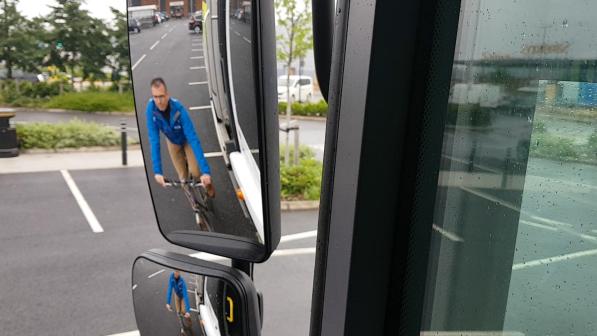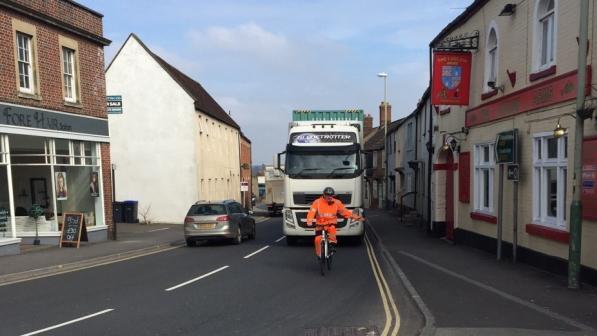Direct vision standards for lorries one step closer in London

Last week, Cycling UK responded to Transport for London's (TfL) consultation on direct vision standards for lorries in London. Direct vision refers to what the driver can see from their cab without using mirrors and cameras, which only afford an indirect view of surrounding road users.
Whilst lorry safety around cyclists and pedestrians is not an issue specific to London, it has had particular resonance in the capital where, despite making up less than 4% of the miles driven, heavy goods vehicles (HGVs) were involved in 78% of cyclist and 20% of pedestrian fatalities in London in 2015. Analysing the statistics over a longer time period, between January 2008 and July 2015, 56 of the 99 cyclist fatalities in London involved lorries, with 29 of those being construction vehicles.
Left hooks and blind spots
Evidence from both research and collision investigations shows that restrictions in HGV drivers' field of direct vision are a contributing factor in many fatal and serious injury collisions involving vulnerable road users. Left hook collisions have been an all too frequent outcome where cyclists near to the front left side of lorries have not been seen by the driver, whereas the blind spot directly in front of the lorry cab, caused by the driver's high seating position, is too often an issue in collisions with pedestrians.
Unsuitable for urban use
Historically, the preferred solution to address lorry blind spots has been to add mirrors to improve the driver's indirect vision. This means that drivers now have six mirrors and often an array of cameras and sensor equipment within and around their cab. Research commissioned by TfL, however, shows that drivers react more quickly when they can see cyclists and pedestrians directly, rather than through the use of mirrors or other equipment, leading to the conclusion that HGV cabs designed to enable drivers to see more of their surroundings directly through their windows, rather than through their mirrors or monitors, significantly reduce the risk of fatal or serious collisions.
Low entry lorries such as the Dennis Eagle Elite and Mercedes Econic, where the driver is surrounded by glass windows in a cab that looks more like the front of a bus than a traditional lorry, are already available, though not in mass production. There is, however, a huge difference in the drivers' direct vision between those lorries (direct vision lorries) and many of the construction vehicles designed to an off-road standard with higher ground clearance, which nevertheless operate predominantly on-road, often in busy urban environments. The latter are not necessarily unsafe or dangerous lorries, they are just unsuitable for use alongside pedestrians and cyclists in busy, congested urban environments.
Direct vision standards and roadmaps
Last year Cycling UK responded to TfL's previous consultation on lorry safety, setting out a proposed roadmap to encourage the wider uptake of direct vision lorries throughout London, with a timetable towards certain lorries being banned from London's roads. A key issue identified by TfL was the absence of any standards to measure, assess and compare the direct view available to drivers of different lorries. Standards existed to measure the indirect vision afforded by mirrors, but not what the driver could see looking out of the cab windows.
Accepting Cycling UK's idea that there needed to be a roadmap for the transition to lorries with improved direct vision, London Mayor Sadiq Khan confirmed last September his plans to achieve this by introducing a direct vision standard using a zero to five star rating system, with the lorries with the best direct vision measured against the standard given five stars. The worst vision zero rated lorries would be banned by January 2020, with only three star and above rated lorries permitted by 2024.
Given that the Mayor's star rating system had not been the subject of a specific consultation, coupled with the logistical complexities of vehicle operators altering their vehicle fleets, the most recent TfL consultation principally concerned the proposed standards and timescales for implementation. Cycling UK responded both independently (see attachment below) and as a member of the Action on Lorry Danger Group (ALD) (see attachment below), which involves organisations including London Cycling Campaign and RoadPeace, both of whom have actively campaigned on lorry safety issues for many years.
Cycling UK and ALD's consultation responses were overwhelmingly in support of the Mayor's proposals, which demonstrate a commitment to tackle lorry safety issues around vulnerable road users. The regulatory scheme should ensure that lorries which were not designed for city use are not driven around London by drivers whose ability to see and give space to vulnerable road users is made more difficult by their restricted direct vision.
Implications beyond London
Further consultations are expected regarding the means of enforcing and regulating any scheme, and objections from those wishing to oppose or delay the Mayor's plans are expected, which is why robust responses are required from vulnerable road user groups to ensure that TfL are aware that there is public support for measures to improve lorry safety.
Whilst the Mayor's plans concern London alone, it is likely that any direct vision standards adopted in London would be followed by any other city, combined authority or region, which seeks to implement similar lorry restrictions, hence what happens in London matters and has long term national significance.


